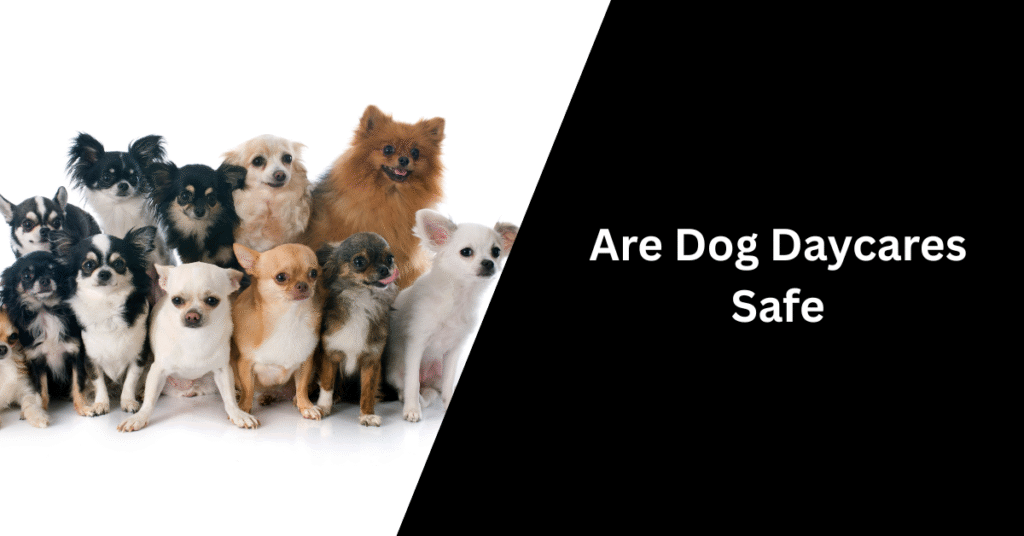Yes, Dog daycares are generally safe when they maintain proper supervision, vaccination policies, and clean facilities. Safety depends on staff-to-dog ratios, temperament evaluations, and secure play areas. Risks include injuries from rough play or exposure to illness, but reputable daycares minimize these with trained staff, health checks, and controlled group sizes.
What “Safe” Dog Daycare Really Means
A safe dog daycare is more than a room full of happy pups. It’s an environment where risk is reduced through smart design, trained staff, and consistent protocols. Look for:
- Clear intake screening: Temperament testing, vaccination verification, and trial days.
- Skilled supervision: Staff trained in canine body language and positive reinforcement handling.
- Thoughtful group management: Dogs grouped by size, age, play style, and energy levels.
- Cleanliness and ventilation: Routine sanitation to reduce illness and odors, with fresh airflow.
- Emergency readiness: Written procedures for fights, injuries, fire, evacuation, weather, and medical crises.
Industry data suggests facilities with strong staff-to-dog ratios, targeted enrichment, and strict cleaning protocols see fewer incidents and better welfare outcomes. When these systems are missing, risks rise—fast.
The Real Risks (And How Good Daycares Reduce Them)
No daycare can promise zero risk. But effective controls dramatically reduce the likelihood and severity of issues:
- Illness transmission: Respiratory infections like kennel cough and canine influenza can spread. Facilities mitigate with vaccination requirements, strict stay-home policies for sick dogs, and enhanced ventilation and cleaning.
- Injury during play: Excited dogs may collide or scuffle. Safer facilities keep small playgroups, use soft surfaces, interrupt arousal early, and avoid overcrowding.
- Stress and burnout: Not every dog loves daycare. Watch for barking, hiding, lip licking, yawning, or shutdown. Good facilities offer rest breaks and quiet zones.
- Behavioral fallout: Over-arousal can worsen manners. Programs that balance enrichment, training reinforcement, and decompression help maintain good behavior.
- Heat or environmental hazards: Outdoor yards need shade, water, and temperature checks; indoor spaces need climate control and non-slip flooring.
From my experience, the most common mistake owners make is assuming “more play = better.” In reality, structured, shorter play sessions with decompression breaks are safest.
How to Evaluate a Dog Daycare Like a Pro
Use this checklist during tours and trial days:
- Staff-to-dog ratio: Aim for 1:10 max in calm groups; 1:6–8 is better for young or high-energy dogs.
- Playgroup sizes: Smaller is safer. Ask how they group (size, temperament, play style).
- Training philosophy: Look for force-free, positive reinforcement handling. Red flags: yelling, harsh corrections, intimidation.
- Supervision and skills: Can staff read canine body language and safely interrupt play? Ask what they’d do if your dog growls or guards.
- Health standards: Require core vaccines (rabies, distemper/parvo) and Bordetella; many also require canine influenza. Clear parasite and flea/tick policies.
- Cleanliness and air: Floors clean and dry? Smell neutral? Good airflow? Visible sanitation routines?
- Rest and routine: Scheduled nap times, rotation between play/enrichment/rest, and access to water.
- Safety features: Double-door entries, secure fencing, surface traction, size-separate rooms, safe toys only.
- Incident reporting: Transparent policies, written reports, and prompt owner communication.
- Insurance and credentials: Ask about liability insurance, staff first-aid/CPR certification, and facility licenses where applicable.
Pro tip from the field: Visit twice—once during peak hours and once at nap time. You’ll learn how they handle high energy and whether dogs truly rest.
Standards, Regulations, And What They Mean For You
Regulation varies widely by city and state. Some areas require specific licenses, inspections, and animal care standards; others do not. In practice:
- Licensing and inspections: Where required, this adds oversight, but quality still varies—always tour.
- Insurance: Reputable facilities carry general and professional liability insurance; ask for proof upon request.
- Staff training: Look for canine first-aid/CPR certification and ongoing education.
- Documentation: Intake forms, vaccine records, behavior notes, and incident logs show professionalism.
Evidence from animal welfare guidelines and veterinary bodies consistently emphasizes the importance of vaccination, sanitation, and qualified supervision for group dog care. If regulations are light where you live, your due diligence matters even more.
What A Safe Day Looks Like Inside Daycare
A well-run day often follows a rhythm:
- Intake and calm entry: Staggered arrivals reduce chaos.
- Morning play in small groups: 15–30 minute play blocks, handlers guiding and rotating dogs.
- Enrichment breaks: Sniffing games, puzzles, flirt poles, basic cues for mental stimulation.
- Midday nap: Crates, suites, or quiet rooms with soft music and low lights.
- Afternoon rotation: Shorter, calmer sessions; more sniff walks or decompression.
- Clean-as-you-go: Spot cleaning throughout; full sanitization after close.
When I managed a facility, shifting from “open play all day” to structured rotations cut scuffles by more than half and improved afternoon behavior.
Is Daycare Right For Your Dog? A Personality Fit Guide
Daycare is not one-size-fits-all. Consider:
- Great candidates: Social butterflies, adolescent dogs with energy, confident adults who enjoy group play.
- Maybe: Seniors or shy dogs may prefer shorter days, smaller groups, or enrichment-only sessions.
- Not ideal: Dogs with fear aggression, resource guarding, intact adults in some groups, or those who guard handlers. Alternatives: day training, enrichment sessions, or one-on-one walks.
Trial days should be slow and supportive. A responsible daycare will say “not a fit” if needed—that’s a sign of integrity, not failure.
Red Flags That Signal “Keep Looking”
Watch out for:
- Overcrowded playrooms or no size/temperament grouping
- High-arousal chaos with constant barking and frantic play
- No proof of vaccines, parasite prevention, or illness policies
- Punitive handling: leash pops, spray bottles, alpha rolls, or intimidation
- Dirty floors, strong ammonia smells, poor ventilation
- Vague answers about incidents or unwillingness to offer a tour
- No rest periods or dogs sleeping only from exhaustion
If a tour feels rushed or you’re discouraged from observing, trust your gut.
Health And Hygiene: What You Should Expect
Cleanliness is non-negotiable:
- Daily sanitation with pet-safe disinfectants on floors, gates, bowls, and toys
- Frequent water bowl changes and labeled personal items
- HVAC and filtration or outdoor airflow to reduce airborne pathogens
- Sick-dog protocols: Isolation areas and send-home policies
You can further protect your dog with up-to-date vaccinations, parasite prevention, and a quick post-daycare rinse for skin sensitive pups.
Costs, Value, And Setting Realistic Expectations
You’re paying for supervision, safety, and structured socialization—not just “tired dog” bragging rights.
- What you’re buying: Professional oversight, safe social contact, enrichment, and routine.
- Why prices vary: Staff training, ratios, facility quality, and added services like report cards or training add-ons.
- A realistic outcome: A content, well-managed fatigue—not total burnout. Dogs should come home relaxed, eat/drink normally, and bounce back by morning.
If your dog returns anxious, hoarse from barking, or too exhausted to eat, discuss adjustments or try a different program.
How To Prepare Your Dog For Daycare Success
Set your pup up for a calm, confident experience:
- Practice short separations at home and with a trusted sitter.
- Refresh basic cues like recall, “leave it,” and polite greetings.
- Pack smart: Current vaccine records, labeled gear, and any meds with instructions.
- Start slow: Half days or 1–2 times per week to build stamina.
- Debrief with staff: Ask what went well and where your dog needed support.
Personal tip: I bring a small bag of my dog’s familiar treats and request handlers use them for calm check-ins. It accelerates trust and keeps arousal in check.
FAQ’s
How Do I Know If My Dog Actually Likes Daycare?
Look for a loose body, tail wagging at the base, normal appetite and sleep, and eager but not frantic drop-offs. Persistent stress signals—whining, excessive drooling, or clinging—mean it’s time to reassess.
What Vaccinations Should Be Required?
Most responsible facilities require rabies and distemper/parvo, plus Bordetella. Many also request canine influenza depending on local outbreaks. Parasite prevention is commonly recommended.
Can Puppies Go To Daycare?
Yes, once they’ve had age-appropriate vaccinations and your vet clears them. Choose programs with small, gentle playgroups and plenty of rest. Short sessions are best.
What’s A Safe Staff-To-Dog Ratio?
Aim for 1:10 as an upper limit in calm groups. For young, small, or high-energy dogs, safer ratios are closer to 1:6–8. Smaller groups mean safer play and faster intervention.
What Should Happen If There’s A Fight Or Injury?
Staff should calmly separate dogs using trained techniques, assess injuries, provide first aid, and contact owners with a written report and next steps. Reputable facilities review incidents to prevent repeats.
Is “All-Day Play” A Good Idea?
Not typically. Structured rotations with rest and enrichment reduce over-arousal, injuries, and behavior regression. Balance beats marathon play.
What If My Dog Gets Sick After Daycare?
Contact your vet and inform the daycare so they can monitor potential spread. Responsible facilities will notify exposed owners and adjust cleaning protocols.
Conclusion
Dog daycares can be safe, enriching, and life-improving—when they’re run with intention. Choose facilities that prioritize small groups, trained staff, force-free handling, rigorous hygiene, and transparent communication. Listen to your dog’s feedback, start slow, and partner with a team that treats safety as a system, not a slogan. Ready to find the right fit? Tour two local daycares this week using the checklist above, ask tough questions, and trust your instincts.
I’ve loved dogs all my life and have cared for many different breeds over the years. Here, I share simple tips, stories, and helpful advice for all dog lovers. Whether you’re a new pet parent or a lifelong dog fan, you’ll find something useful and fun on my site.


